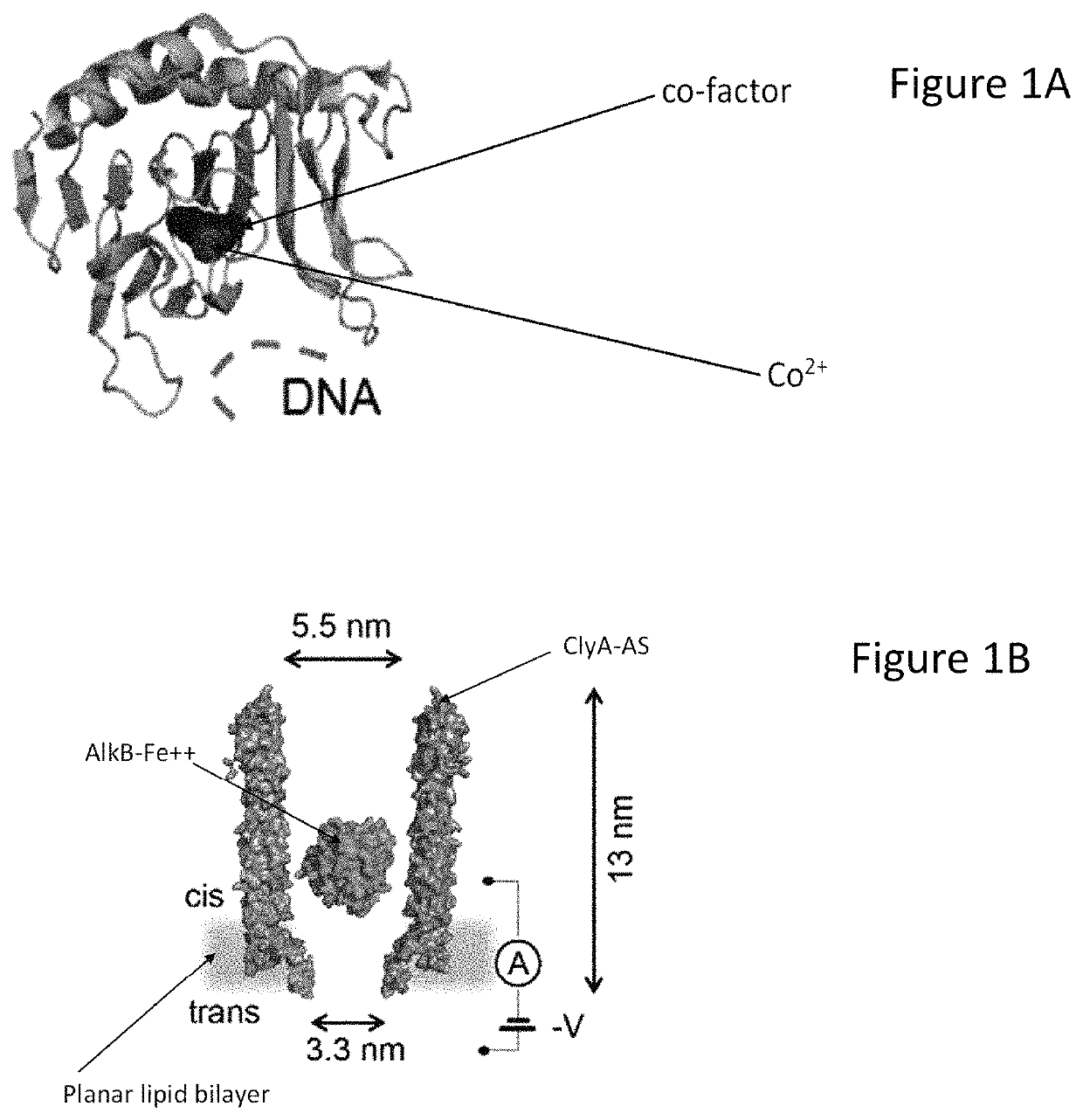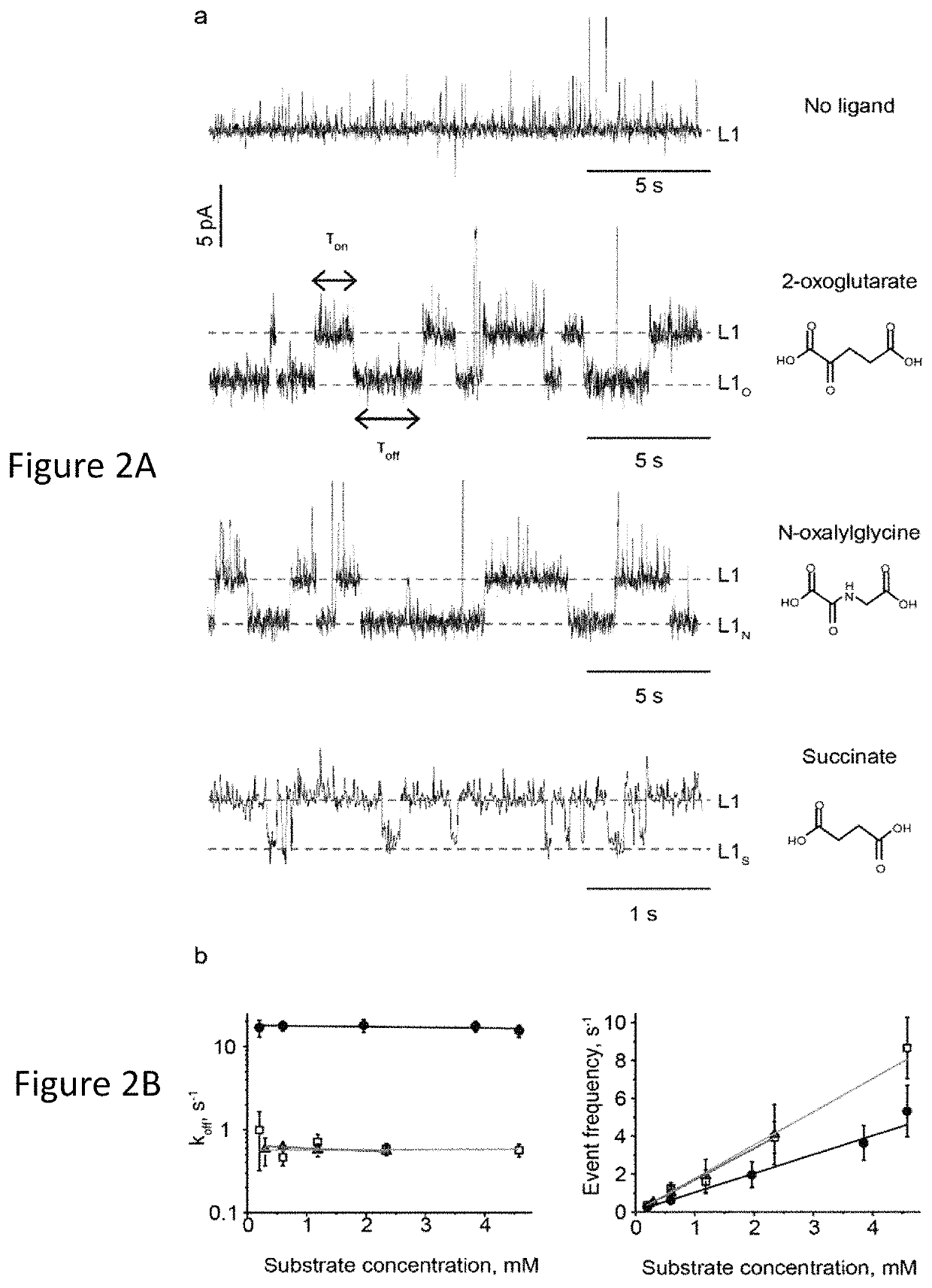Nanopores with internal protein adaptors
a technology of protein adaptors and nanopores, applied in the field of nanopore sensors, can solve the problems of complex identification of specific analytes, difficult building such hybrid devices, and proteins that cannot be expected to retain their structure or function
- Summary
- Abstract
- Description
- Claims
- Application Information
AI Technical Summary
Problems solved by technology
Method used
Image
Examples
example 1
Material & Methods
[0099]Unless otherwise specified all chemicals were bought from Sigma-Aldrich. DNA was purchased from Integrated DNA Technologies (IDT), enzymes from Fermentas and lipids from Avanti Polar Lipids. Stocks of NADPH and NADP+ (prepared in 15 mM Tris.HCl pH 7.5 150 mM NaCl) were kept at −20° C. and defrosted for single use. All errors in this work are given as standard deviations. The standard deviations (SD) for the values calculated from linear fits (FIG. 1e, FIG. 2e) were calculated from standard errors (SE) given by the fit by applying the formula
[0100]SE=SDN
where N is the number of independent data points in the graph.
[0101]AlkB Cloning
[0102]To allow cloning, a Nco I site (CCATGG) was introduced in the wild type AlkB from E. coli at the beginning of the gene (5′ end). To keep the gene in reading frame an additional two bases were inserted after the Nco I site, resulting in an additional alanine residue after the starting methionine. For purification purposes, at t...
example 2
A Demethylase as a Protein Adaptor
[0124]As a first model protein we selected E. coli AlkB demethylase (Mw=25 kDa), a globular protein that is expected to pass the cis entry of ClyA, but is too large to traverse the trans exit of the nanopore (FIG. 1a,b). In complex with iron ions (AlkB-Fe++) AlkB co-oxidises methylated DNA and its cofactor 2-oxoglutarate (2-OG), producing succinate (SUC), carbon dioxide and formaldehyde (Aravind, L. & Koonin, E. V. (2001) Genome biol. 2, RESEARCH0007; Trewick, S. C. (2002) Nature 419, 174-178), 2-oxoglutarate is an important metabolite that influences aging and age-related diseases (Chin, R. M. et al. (2014) Nature, 510, 397-401), and is a biomarker for non-alcoholic fatty liver disease (Rodriguez-Gallego, E. (2015) Int. j. obesity 39, 279-287), heart failure and cardiorenal syndrome (Nikolaidou, T. et al. (2010) Heart, 96, e14). The level of succinate in urine is a biomarker for kidney damage (Peti-Peterdi, J. (2014) U.S. Pat. No. 8,652,771).
[0125]...
example 3
A Reductase as a Protein Adaptor
[0132]E. coli dihydrofolate reductase (DHFR, Mw=19 kDa) was selected as a second model protein adaptor (FIG. 3a,b). During the DHFR catalytic cycle dihydrofolate is reduced to tetrahydrofolate and the cofactor NADPH is oxidised to NADP+. Tetrahydrofolate is a cofactor in many metabolic reactions, thus inhibitors of DHFR such as methotrexate (MTX) are antibiotic and anticancer agents. The ratio of the NADP+ and NADPH intracellular concentrations is used to monitor the oxidative stress in cells (Ogasawara, Y. et al. (2009) Biol. &pharmaceut. bull. 32, 1819-1823). We found that apo-DHFR, which is smaller than AlkB, dwelled inde ClyA-AS only for a few milliseconds. Upon the addition of MTX to the cis solution the frequency and the dwell time of the protein blockades decreased, while the residual current increased. The blockades were then abolished by the subsequent addition of NADPH to the same side (FIG. 11). Since both the inhibitor and the cofactor are...
PUM
| Property | Measurement | Unit |
|---|---|---|
| trans-diameter | aaaaa | aaaaa |
| trans-diameter | aaaaa | aaaaa |
| pH | aaaaa | aaaaa |
Abstract
Description
Claims
Application Information
 Login to View More
Login to View More - R&D
- Intellectual Property
- Life Sciences
- Materials
- Tech Scout
- Unparalleled Data Quality
- Higher Quality Content
- 60% Fewer Hallucinations
Browse by: Latest US Patents, China's latest patents, Technical Efficacy Thesaurus, Application Domain, Technology Topic, Popular Technical Reports.
© 2025 PatSnap. All rights reserved.Legal|Privacy policy|Modern Slavery Act Transparency Statement|Sitemap|About US| Contact US: help@patsnap.com



